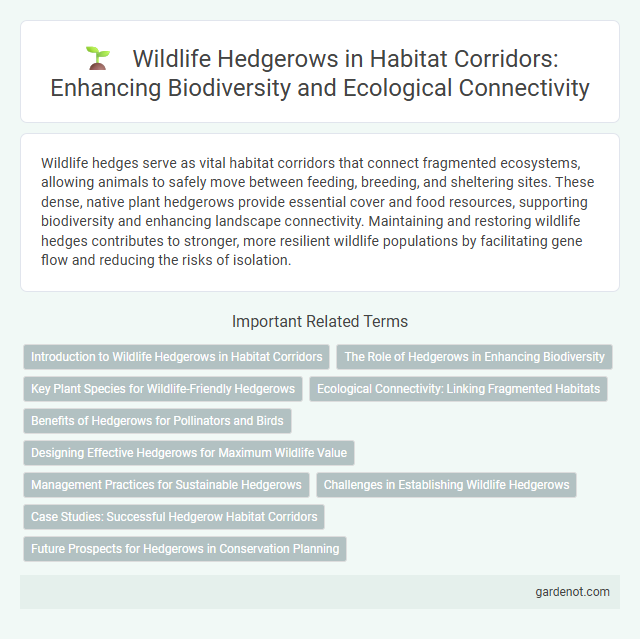Wildlife hedges serve as vital habitat corridors that connect fragmented ecosystems, allowing animals to safely move between feeding, breeding, and sheltering sites. These dense, native plant hedgerows provide essential cover and food resources, supporting biodiversity and enhancing landscape connectivity. Maintaining and restoring wildlife hedges contributes to stronger, more resilient wildlife populations by facilitating gene flow and reducing the risks of isolation.
Introduction to Wildlife Hedgerows in Habitat Corridors
Wildlife hedgerows serve as vital habitat corridors, connecting fragmented ecosystems and enabling safe movement for various species. These dense, linear plantings provide shelter, food resources, and nesting sites for birds, insects, and small mammals, enhancing biodiversity across agricultural and urban landscapes. Integrating native shrubs, trees, and wildflowers in hedgerows supports ecological balance and strengthens habitat connectivity.
The Role of Hedgerows in Enhancing Biodiversity
Hedgerows serve as vital habitat corridors that facilitate wildlife movement and connect fragmented ecosystems, enhancing overall biodiversity. These linear habitats provide shelter, nesting sites, and food resources for various species including birds, insects, and small mammals. By linking isolated patches of woodland and grassland, hedgerows support gene flow and increase ecological resilience in agricultural landscapes.
Key Plant Species for Wildlife-Friendly Hedgerows
Wildlife hedges play a crucial role in habitat corridors by providing shelter and food resources for diverse fauna. Key plant species such as hawthorn (Crataegus monogyna), blackthorn (Prunus spinosa), and hazel (Corylus avellana) support pollinators, birds, and small mammals through their flowers, fruits, and dense foliage. Incorporating native shrubs like elderberry (Sambucus nigra) and dog rose (Rosa canina) enhances biodiversity by promoting insect populations and serving as nesting sites within wildlife-friendly hedgerows.
Ecological Connectivity: Linking Fragmented Habitats
Wildlife hedges play a crucial role in ecological connectivity by linking fragmented habitats, allowing the safe movement of species across agricultural and urban landscapes. These linear vegetation structures serve as green corridors that facilitate gene flow, breeding opportunities, and access to resources, thereby enhancing biodiversity. Their presence mitigates habitat fragmentation, supporting ecosystem resilience and long-term wildlife survival.
Benefits of Hedgerows for Pollinators and Birds
Hedgerows serve as vital habitat corridors that enhance biodiversity by providing nectar, pollen, and shelter for pollinators such as bees and butterflies, supporting their foraging and breeding activities. They offer nesting sites, protection from predators, and migration pathways for various bird species, promoting avian diversity and population stability. The structural complexity of hedgerows also aids in maintaining ecosystem health by facilitating pollination services and natural pest control.
Designing Effective Hedgerows for Maximum Wildlife Value
Designing effective hedgerows for maximum wildlife value requires selecting native plant species that provide food, shelter, and nesting sites for diverse fauna, including birds, insects, and small mammals. Structuring hedges with varying heights and densities promotes habitat complexity, enhancing biodiversity and ecological connectivity within habitat corridors. Incorporating seasonal flowering and fruiting plants supports year-round wildlife activity and contributes to ecosystem resilience.
Management Practices for Sustainable Hedgerows
Effective management practices for sustainable hedgerows include regular trimming to promote dense growth and prevent overgrowth, enhancing habitat connectivity for wildlife species. Incorporating native plant species supports biodiversity by providing food and shelter for pollinators, birds, and mammals. Monitoring soil health and implementing organic mulch can improve plant resilience and maintain ecological balance within the corridor.
Challenges in Establishing Wildlife Hedgerows
Establishing wildlife hedgerows faces challenges including limited land availability in urban or agricultural areas, which restricts corridor continuity and species movement. Invasive plant species can outcompete native vegetation, reducing habitat quality and biodiversity support. Maintenance requirements and potential conflicts with land use priorities further complicate long-term hedgerow sustainability and ecosystem benefits.
Case Studies: Successful Hedgerow Habitat Corridors
Case studies of successful wildlife hedge habitat corridors demonstrate significant improvements in biodiversity by connecting fragmented landscapes and facilitating animal movement. In regions like the UK's South Downs, restored hedgerows have increased native bird and insect populations by up to 40%, while also supporting small mammal dispersal. These corridors play a crucial role in enhancing ecosystem services such as pollination, pest control, and soil stabilization.
Future Prospects for Hedgerows in Conservation Planning
Wildlife hedges play a crucial role in habitat corridors by providing essential shelter and food resources for numerous species, enhancing biodiversity connectivity. Future prospects for hedgerows in conservation planning include integrating advanced ecological data and remote sensing technology to optimize their placement and management. Increasing emphasis on hedgerows as natural infrastructure supports climate resilience and promotes sustainable land-use practices across agricultural and urban landscapes.
Wildlife hedge Infographic

 gardenot.com
gardenot.com